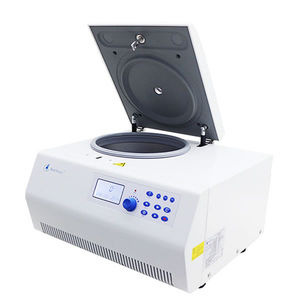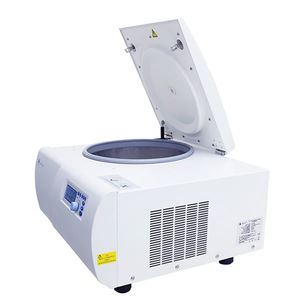
- Company
- Products
- Catalogs
- News & Trends
- Exhibitions
Laboratory centrifuge Neofuge 15for DNAbenchtopswing-out
Add to favorites
Compare this product
Characteristics
- Applications
- laboratory
- Sample type
- for DNA
- Configuration
- benchtop
- Rotor type
- swing-out
- Performance
- high-capacity, high-speed
- Speed
Min.: 300 rpm
(1,885 rad.min-1)Max.: 16,000 rpm
(100,531 rad.min-1)
Description
Features
- Spin up to 16,000rpm or 20,800×g
- Max. capacity of 400ml
- Induction drive without carbon brushes
- Powerful motors for short acceleration and braking times
- Broad range of adaptors and modular accessories
User-frindliness
- Large back-lit LCD screen and easy-to-clean keypad comprise the user-friendly control panel
- Time, temperature(refrigerated models), g-force/speed are easily entered
- Most values can be changed during centrifugation
- Quick spin key enables quick runs at your desired rotational speed
- Nine acceleration and braking ramps are available for sensitive samples
- The last user program used stays automatically on display
Safety Design
- Lid locking and holding during rotor run
- Emergency lid-lock release
- Motor-overheating protection
- Automatic rotor identification
- Electronic imbalance detection
Modular adaptors
- The modular construction of adaptors allow centrifugation of pratically all commercially available tubes
- The adapters are solidly constructed and can be easily cleaned and autoclaved in event of contamination with biologically active sample material
Versatility
Fixed angle, swinging bucket, microliter rotors for all common tubes from 0.2 to 100 are available for applications using microliter, DIN, blood sample and FalconTM type conical tubes.
Catalogs
Related Searches
- Upright refrigerator
- Laboratory freezer
- Laboratory refrigerator
- 1-door freezer
- Laboratory centrifuge
- Tabletop centrifuge
- Pharmacy refrigerator
- Blood centrifuge
- 2-door refrigerator
- Stainless steel freezer
- Refrigerator on casters
- Automated centrifuge
- Swing-out centrifuge
- Fixed-angle centrifuge
- Clinical centrifuge
- Refrigerated centrifuge
- High-speed centrifuge
- Low-temperature freezer
- High-capacity centrifuge
- DNA centrifuge
*Prices are pre-tax. They exclude delivery charges and customs duties and do not include additional charges for installation or activation options. Prices are indicative only and may vary by country, with changes to the cost of raw materials and exchange rates.








